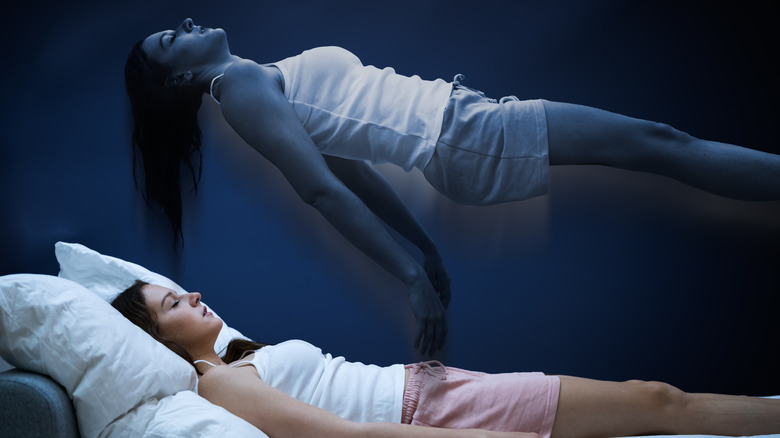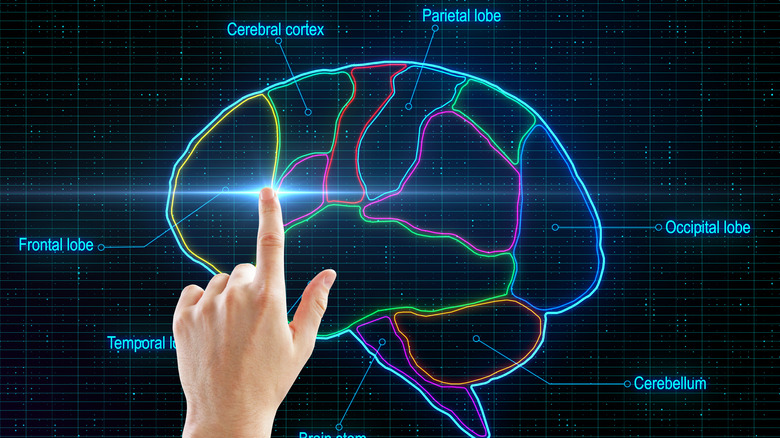The Truth Behind Lucid Dreaming And How It Works
In the 2010 film "Inception," Leonardo DiCaprio is a thief who steals secrets by entering his victim's dreams. In "The Cell" (2000), Vince Vaughan and Jennifer Lopez enter the mind of a comatose serial killer to find his final victim. Then, of course, there is the long string of "Nightmare on Elm Street" horror movies and the lesser well-known "Dreamscape" (1984), where if a person dies in their dreams, they die in real life.
People are fascinated by the world of dreams, and it is not just pop culture. Dreams have played a prominent role in traditional stories and practices of world religions. Research in Frontiers in Psychology observed that in Western religions such as Judaism, Christianity, and Islam, dreams are considered a means to communicate with God. Consider the story from Genesis of Joseph interpreting the dreams of his brothers. Then in Eastern religions, like Hinduism and Buddhism as well as Native American beliefs, dreams are a spiritual tool.
The idea of consciously interacting with a dream is an essential part of lucid dreaming. This is a verified phenomenon that may be learned. So, if this appeals to you, then read on as we look at the truth behind lucid dreaming and see how it works.
What is lucid dreaming?
People, when they sleep, have dreams, which are essentially hallucinations of the mind. As to why people dream, Healthline reports that it is a highly debated topic ranging from physiological to psychological reasons. Normally, when people dream, they do not know that they are dreaming and often forget their dreams shortly after waking. However, many people experience special types of dreams called lucid dreams. In lucid dreams, the people experiencing the dreams are consciously aware that they are dreaming. According to Frontiers in Psychology, the term "lucid dream" was first invented in 1913 by the Dutch psychiatrist Frederik Willem van Eeden in his "A Study of Dreams." The modern science and study of lucid dreaming are credited to Stephen LaBerge, whom Wired calls the "Thomas Edison of lucid dreaming." Much of what we understand about lucid dreaming today comes from his research and experimentation.
Sometimes, a lucid dream might just be an awareness of dreaming, while at the other end of the spectrum, some people can exert some level of control over their dreams. This latter skill, at least according to the Sleep Foundation, is limited to a small slice of the population. However, many people do have lucid dreams. Interestingly, the majority of the population experiences lucid dreaming without even trying — more than 50% at least once in their lifetime and more than 20% at least once a month – according to Science Direct.
When does lucid dreaming occur?
When a person sleeps, they pass through various stages of what is called the sleep cycle. These stages, as described by Healthline, are broadly divided into non-REM and REM phases. The non-REM phase is broken into various stages including falling asleep, light sleep, and deep sleep. During this time, your temperature lowers as the body regenerates itself. In the third and deepest stage of sleep, delta waves are recorded, a result of lower brain activity. After this, the sleeper slips into the REM phase.
REM stands for "Rapid Eye Movement," in which the eyes move about quickly in various directions. REM sleep is thought to provide cognitive maintenance, which helps with mood, learning, and memory. Through the night, a sleeper experiences REM every 90 minutes. During REM, brain activity increases, heart rate picks up, and the limbs become temporarily paralyzed. This latter element is important since it is generally during REM that sleepers dream, and not being able to move your muscles prevents dreamers from acting out their dreams in reality. In the early part of the night, REM is brief, lasting at first about 10 minutes (via Healthline). By the end of the night, REM can last up to an hour. Since lucid dreaming invariably occurs during REM, there is an opportunity to lucid dream in lengthening intervals of 90 minutes every night.
Why do people have lucid dreams?
During sleep, different areas of the brain activate or deactivate. According to research published in Consciousness and Cognition, when one experiences a typical dream, areas of the brain which are associated with awareness and waking are deactivated. This also impacts the ability to remember dreams after you wake up. Since researchers suspected that this area of the brain might play an important role in lucid dreaming, they tested the hypothesis by enlisting high school students and giving them games that assessed this area of the brain. Then, they studied the students for occurrences of lucid dreams. They found that the ventromedial prefrontal cortex seems to play a role. The prefrontal cortex, in general, is the region of the brain that controls your consciousness, serving in decision-making function. Nature tells us that the ventromedial prefrontal cortex plays a role in emotional regulation. Further research also shows connections between the anterior prefrontal cortex and parietal cortex, areas which are typically deactivated during regular sleep.
How do you enter a lucid dream?
Sleepers can enter a lucid dream in a number of ways. Healthline reports that one way is Wake Initiated Lucid Dreaming (WILD). In WILD, a person goes directly from a conscious state into a dream state. It is believed that because a person is moving straight into dreaming that it increases the chances of experiencing a lucid dream. It is also considered more difficult than Dream Initiated Lucid Dreaming (DILD). "The Lucid Dreaming Workbook" explains that in this entry method, a person falls asleep, and something occurs within the dream that makes one realize that they are dreaming. There is no way yet to directly induce WILD or DILD (i.e., you can't pop a lucid dream pill, although there are devices on the market, such as masks, which anecdotally are supposed to help). If a person does nothing, lucid dreams will just occur spontaneously. But for those who wish to become dream journeyers, called oneironauts, there are training methods that you can use which will increase your chances of having a lucid dream experience.
How do you induce a lucid dream through reality testing?
One training method lucid dreamers use is called reality testing, or the reality check. The Sleep Foundation explains that this entails regularly checking to make sure you are not dreaming. Healthline explains that one of the most common techniques is to ask yourself if you are dreaming and then check your surroundings to see if anything is out of the ordinary. There are also a number of other tried and true methods. A person can pinch their nose and try to breathe -– if you can, then you are dreaming. One might look in a mirror. If you look like how you ought to look, then you are probably awake. Another test entails looking at a clock, looking away, then looking at it again. If the time has changed drastically, then you are dreaming. Somebody may conduct a reality test by pushing something hard and solid. If your hands go through, you are either a kung-fu master or dreaming.
"Lucid Dreaming, Waking Life," provides more unorthodox examples, such as trying to fly. More dedicated oneironauts recommend doing multiple reality tests of different types. As noted in "Lucid Dreaming, Waking Life" the problem with reality tests is that the results are not guaranteed since you expect something to happen or not to happen. However, it should be noted that Frontiers in Psychology has published research that shows that reality testing may not work as well as other methods, if at all.
How does keeping a dream journal increase lucid dreaming?
When most people wake up, they soon forget their dreams. Live Science explains that the reasons why this happens are largely unknown, but it may be because of neurochemical conditions that change when you shift from sleep to wakefulness or the sequence for how the brain wakes up, or that you might just be having a really dull dream. To lucid dream, however, you have to develop a strong ability to recall your dreams. Lucid dreamers often do this by keeping a dream journal. "Remember Your Dreams" suggests that besides writing down your dreams, another technique is to draw a picture of the dream. This all contributes to cementing the dream into your long-term memory and thus increasing your dream awareness.
Of course, part of the trouble with doing this is that it requires the sleeper to have a paper and pencil by the bedside. It is imperative that you write down the dream as quickly as possible before you forget it, so you may have to scribble in the dark. Thankfully, some of the most vivid dreams occur in the early morning when REM cycles are at their longest, so the chances that you'll have better light to write by are greater.
How do you talk yourself into lucid dreaming?
Another trick oneironauts have developed is to talk themselves into lucid dreaming. Frontiers in Psychology tells us that the technical terminology for this method is Mnemonic Induction of Lucid Dreams (MILD). When you sleep through the night, you periodically wake up. Most of the time you don't even notice it. However, committed lucid dreamers will, upon waking, repeat a phrase about remembering their dream. This mantra then becomes ingrained into the consciousness and encourages lucid dreaming. MILD is also particularly effective if you fall asleep again quickly after performing it. The study published in Frontiers in Psychology shows that 45.8% of the time after subjects performed MILD and then fell asleep within five minutes, they experienced a lucid dream. Dr. Denholm Aspy of the University of Adelaide commented, "The MILD technique works on what we call 'prospective memory' –- that is, your ability to remember to do things in the future. By repeating a phrase that you will remember you're dreaming, it forms an intention in your mind that you will, in fact, remember that you are dreaming, leading to a lucid dream."
A newer but related technique to MILD is called Senses Initiated Lucid Dream (SSILD). This technique entails the sleeper to wake up after five hours of sleep and then shift their attention between visual, auditory, and tactile sensations before going back to sleep. It is about as effective as MILD.
How does waking up in the middle of the night induce lucid dreaming?
If you inadvertently wake up in the middle of the night and then take a while to fall back to sleep again, you may experience particularly vivid dreams when you do. This phenomenon is a lucid dreaming induction technique called Wake Back to Bed (WBTB). Frontiers in Psychology explains how in this technique, you purposefully wake up for a period of time after several hours of sleep before going to sleep again. "Are You Dreaming?" suggests the best way to do this is by setting your alarm, then getting up and occupying yourself for 30 to 90 minutes — just enough so that you stay awake, but not too awake so you can't fall back asleep. You then return to bed. Typically, a lucid dreamer will add another technique, such as MILD, in the hopes of entering a WILD lucid state.
How do you control your dreams while lucid dreaming?
Being able to control your dreams sounds like a cool thing, but at the end of the night, it usually takes a good amount of training. Psychology Today writes that the level of control an individual sleeper has in a lucid dream varies greatly from person to person. The most advanced oneironauts are able to defy physics: They can pass through walls, fly through the dreamscape, or they can control what appears or disappears. However, typical lucid dreamers can usually only control their actions, thoughts, and behaviors, but not necessarily the subject of the dream itself.
Several strategies have been recommended by Psychology Today as to how an individual can reach greater levels of lucidity while dreaming. One way is through the dream body. For example, a dreamer may jump higher and higher until they fly. Another kind is enunciating what you want to happen while in the dream. If that lion is chasing after you in your dreamscape savannah, try shouting, "Stop!" and see what happens. If it keeps coming, maybe it is time to do a reality check. Other types of strategies involve controlling one's emotions and sending positive thoughts to characters within the dream. Still, other strategies involve conjuring dream portals to change the dreamscape. Others visualize things they desire to occur. Do you want Leonardo Dicaprio to pop into your dream soiree? Just will him into existence. As you can see, there are many paths lucid dreamers take to achieve dream control.
How do you wake up from a lucid dream?
As surprising as it might sound, some people want to wake up from a lucid dream. Maybe you have to get to work. Whatever the reason, Healthline has made a few suggestions for how to retire from your dreamscape. One typical method is to just fall asleep in your dream. Blinking repeatedly is also known to work as well as shouting inside your dream. Lastly, you can try reading. It is suggested that trying to read within a dream may activate more conscious parts of your brain, thus waking you up.
Conversely, sometimes the dreamscape just crumbles around the dreamer. If this happens and you want to keep the lucid dream going, Psychology Today tells us that dreamers can use certain stabilization techniques. This might mean focusing on something in the dream, or simply concentrating on breathing. One technique offered by "Lucid Dreaming" is to spin within the dream. This may restore the dreamscape. It is thought that the sensation of movement to your dream self restores the integrity of the dream.
What are the benefits of lucid dreaming?
Aside from it being cool to be able to lucid dream, there are tangible benefits. According to an International Journal of Dream Research survey, lucid dreaming has positive psychological benefits. It is conducive to emotional and mental healing, plus it is thought to improve problem-solving abilities. Lucid dreaming can also effectively reduce nightmares and the anxieties associated with them. Simultaneously, lucid dreaming has an empowering ability that improves one's self-esteem and can improve one's mood.
The exact use of lucid dreams for each of these purposes varies per person. However, generally, younger people (who are more prone to naturally lucid dreams) use this form of dreaming as a sort of personal holodeck -– a place for wish fulfillment. Older lucid dreamers are more likely to employ lucid dreaming for healing purposes or trying to solve a problem that they face in the waking world.
Another serious use for lucid dreaming may be to cope with trauma. Research published in Frontiers in Psychology evaluated the use of lucid dreaming as a therapy technique for those with post-traumatic stress disorder (PTSD). While no reduction in nightmares was found, lucid dreaming was shown to significantly lower stress and anxiety in PTSD victims.
What are the dangers of lucid dreaming?
As great as lucid dreaming may sound, there are several potential downsides to it. Research in Frontiers in Psychology suggests that lucid dreaming may or may not result in fragmented sleep and lowered sleep quality. The researchers noted that failed induction techniques, such as when performing MILD and failing to fall asleep again quickly, could be a cause for poor sleep quality.
And for all the potential psychological benefits of lucid dreaming, there are risks. The International Journal of Dream Research published findings in which some lucid dreamers became trapped in nightmares in which they could not wake up nor control the dream. An additional study published by Frontiers in Psychology showed that lucid dreaming, especially when actively trying to induce them, could result in dissociation and stress. In this case, the researchers advised that lucid dreaming can be positive or negative depending on who the dreamer is and their personal psychology. This is supported by one study which asserts that people who already have psychosis can be further harmed by lucid dreaming.
Thus, the truth about lucid dreaming is that it is an individual choice. A person must assess their own mental well-being before taking the step of becoming a dream oneironaut.












